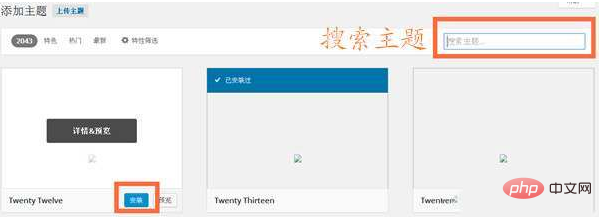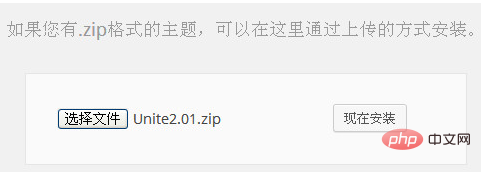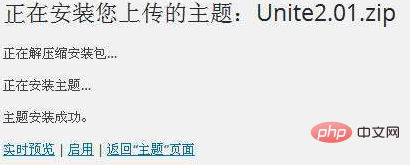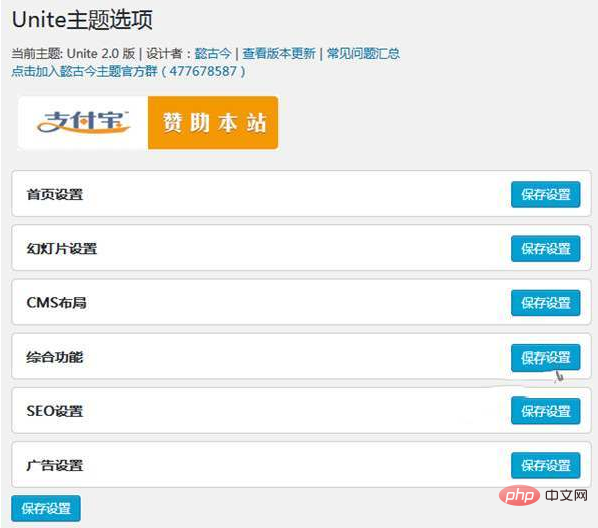How to use wordpress theme (graphic tutorial)

How to use wordpress theme (picture and text tutorial)
One of the world-famous WordPress themes is that it has many themes Templates include blog themes, CMS themes, Taobao themes, online store themes, corporate themes, picture themes, etc. The themes shared for free are enough for most of us bloggers and webmasters to use. So today, we will briefly explain to you the installation and use of WordPress themes.
Related recommendations: " Recommendations for a variety of WordPress corporate themes [free download]"
There are generally three common methods for installing WordPress themes:
First method: Search and install online (but not all themes can be searched)
Visit the backend->Appearance->Theme->Add, enter the theme keyword, Search for the corresponding theme name, and when found, click [Install] in the lower right corner of the theme thumbnail.

# PS: The themes searched here are basically foreign themes, and domestically produced themes are basically not submitted to the WordPress theme library, so it is difficult for us The theme we want is found here, so this method can be ignored.
Second: Upload theme file installation online (the most common method)
Most bloggers and webmasters use this method, which is to find WordPress themes on the Internet now. Then download the theme installation package to your local computer, then log in to the WordPress backend ->Appearance ->Theme ->Add ->Upload theme -> Click [Select File] to select the theme installation package we just downloaded (with Take the Unite theme I made as an example)—>Click [Install Now].

If the following picture appears, it means that we have successfully installed the Unite theme, and then you can click [Enable] to apply the WordPress theme.

Third method: Upload theme files through FTP (not themes in .zip format)
In fact, most WordPress themes can be used through the second method Install, but a small number of themes are not installation packages in .zip format, so they cannot be installed through the second method. At this time, we can upload the entire installation package file (the file obtained by decompressing the theme installation package) to the /wp-content/theme directory in the root directory of the website through FTP, and then log in to the WordPress backend->Appearance->Theme and find Just click [Enable] on the theme you just uploaded.

The themes we have installed can be found in the background—>Appearance—>Theme. If you like the theme, just activate the corresponding theme directly.
Each WordPress theme needs to be set up after it is enabled (except for a few that do not have theme background setting options). This time we enable the Unite theme we just uploaded to see the effect. After clicking Unite theme [Enable] successfully, you will automatically jump to the theme's option settings page, as shown in the figure below.

Since it is our first time to use this theme, we fill in the options one by one according to the theme and save the settings You can use this theme normally.
PS: The settings of each theme are different, so I won’t demonstrate them one by one here. It is recommended that before using a certain theme, you first read the usage instructions of the theme and install it locally for testing. It is more appropriate to upload it to the host space after it is normal.
For more WordPress technical articles, please visit the WordPress Tutorial column!
The above is the detailed content of How to use wordpress theme (graphic tutorial). For more information, please follow other related articles on the PHP Chinese website!

Hot AI Tools

Undresser.AI Undress
AI-powered app for creating realistic nude photos

AI Clothes Remover
Online AI tool for removing clothes from photos.

Undress AI Tool
Undress images for free

Clothoff.io
AI clothes remover

Video Face Swap
Swap faces in any video effortlessly with our completely free AI face swap tool!

Hot Article

Hot Tools

Notepad++7.3.1
Easy-to-use and free code editor

SublimeText3 Chinese version
Chinese version, very easy to use

Zend Studio 13.0.1
Powerful PHP integrated development environment

Dreamweaver CS6
Visual web development tools

SublimeText3 Mac version
God-level code editing software (SublimeText3)

Hot Topics
 How to adjust the wordpress article list
Apr 20, 2025 am 10:48 AM
How to adjust the wordpress article list
Apr 20, 2025 am 10:48 AM
There are four ways to adjust the WordPress article list: use theme options, use plugins (such as Post Types Order, WP Post List, Boxy Stuff), use code (add settings in the functions.php file), or modify the WordPress database directly.
 What are the plugins for wordpress blocking ip
Apr 20, 2025 am 08:27 AM
What are the plugins for wordpress blocking ip
Apr 20, 2025 am 08:27 AM
WordPress IP blocking plugin selection is crucial. The following types can be considered: based on .htaccess: efficient, but complex operation; database operation: flexible, but low efficiency; firewall: high security performance, but complex configuration; self-written: highest control, but requires more technical level.
 How to write a header of a wordpress
Apr 20, 2025 pm 12:09 PM
How to write a header of a wordpress
Apr 20, 2025 pm 12:09 PM
The steps to create a custom header in WordPress are as follows: Edit the theme file "header.php". Add your website name and description. Create a navigation menu. Add a search bar. Save changes and view your custom header.
 How to cancel the editing date of wordpress
Apr 20, 2025 am 10:54 AM
How to cancel the editing date of wordpress
Apr 20, 2025 am 10:54 AM
WordPress editing dates can be canceled in three ways: 1. Install the Enable Post Date Disable plug-in; 2. Add code in the functions.php file; 3. Manually edit the post_modified column in the wp_posts table.
 How to change the head image of the wordpress theme
Apr 20, 2025 am 10:00 AM
How to change the head image of the wordpress theme
Apr 20, 2025 am 10:00 AM
A step-by-step guide to replacing a header image of WordPress: Log in to the WordPress dashboard and navigate to Appearance >Theme. Select the topic you want to edit and click Customize. Open the Theme Options panel and look for the Site Header or Header Image options. Click the Select Image button and upload a new head image. Crop the image and click Save and Crop. Click the Save and Publish button to update the changes.
 What to do if there is an error in wordpress
Apr 20, 2025 am 11:57 AM
What to do if there is an error in wordpress
Apr 20, 2025 am 11:57 AM
WordPress Error Resolution Guide: 500 Internal Server Error: Disable the plug-in or check the server error log. 404 Page not found: Check permalink and make sure the page link is correct. White Screen of Death: Increase the server PHP memory limit. Database connection error: Check the database server status and WordPress configuration. Other tips: enable debug mode, check error logs, and seek support. Prevent errors: regularly update WordPress, install only necessary plugins, regularly back up your website, and optimize website performance.
 WordPress website account login
Apr 20, 2025 am 09:06 AM
WordPress website account login
Apr 20, 2025 am 09:06 AM
To log in to a WordPress website account: Visit the login page: Enter the website URL plus "/wp-login.php". Enter your username and password. Click "Login". Verification Two-step Verification (optional). After successfully logging in, you will see the website dashboard.
 How to display wordpress comments
Apr 20, 2025 pm 12:06 PM
How to display wordpress comments
Apr 20, 2025 pm 12:06 PM
Enable comments in WordPress website: 1. Log in to the admin panel, go to "Settings" - "Discussions", and check "Allow comments"; 2. Select a location to display comments; 3. Customize comments; 4. Manage comments, approve, reject or delete; 5. Use <?php comments_template(); ?> tags to display comments; 6. Enable nested comments; 7. Adjust comment shape; 8. Use plugins and verification codes to prevent spam comments; 9. Encourage users to use Gravatar avatar; 10. Create comments to refer to






